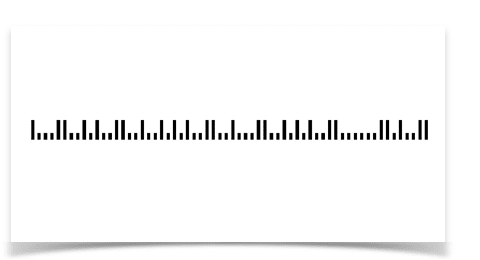
Postal Barcodes
Postal barcodes overview
The Postal Barcode can be a 1D, a 2D barcode or even a 2 State- or 4 State-barcode. It is primarily used in the postal service and can cover numerous properties, e.g. Sender and addressee information, geographic information and postage.
2 State-Barcode

Onecode
The barcode is also known as Intelligent Mail, OneCode 4CB, USPS 4CB, 4-CB, 4-State Customer Barcode, USPS OneCode Solution Barcode, and USPS IM.
The barcode Onecode (formerly called 4-State Customer Barcode) is a clocked barcode and a newly developed USPS barcode for sorting and tracking mail pieces. The barcode combines the features of (former) barcodes POSTNET and Planet.
Application area: postal system

Planet
The barcode is also known as USPS PLANET Barcode, and USPS Confirm Service Barcode.
The barcode Planet (Postal Alpha Numeric Encoding Technique) is a clocked barcode used by the United States Postal Service to identify and track mail pieces during delivery. The barcode was replaced by Intelligent Mail Barcode. The barcode uses numeric input data and a modulo-10 check digit. The barcode has a variable length of 62 to 72 bars.
Application area: postal system

POSTNET variable-length Barcode
The barcode is also known as USPS POSTNET Barcode, USPS POSTal Numeric Encoding Technique Barcode, Delivery Point Barcode (DPBC), and Postnet 3 of 5.
The barcode POSTNET (POSTal Numeric Encoding Technique) is a clocked barcode and was developed in the United States for the automatic sorting of mail pieces. The barcode POSTNET is only used for address identification. POSTNET is not a real barcode, since a barcode is coded by bars of variable width, while the barcode POSTNET is coded by bars of variable height. It is a numeric barcode that uses five bars (two long and three short) and four spaces for each encoded character. The length of the bars and the spaces between them are constant throughout the code.
POSTNET Code variants:
- ZIP code: 5 digits + check digit
- ZIP code + 4: 9 digits + check digit
- ZIP code + 4 + Delivery Point: 11 digits + check digit
Application area: postal system

POSTNET 5-Digit Barcode
The barcode is also known as USPS POSTNET Barcode, USPS POSTal Numeric Encoding Technique Barcode, Delivery Point Barcode (DPBC), and Postnet 3 of 5.
The barcode POSTNET (POSTal Numeric Encoding Technique) is a clocked barcode and was developed in the United States for the automatic sorting of mail pieces. The barcode POSTNET is only used for address identification. POSTNET is not a real barcode, since a barcode is coded by bars of variable width, while the barcode POSTNET is coded by bars of variable height. It is a numeric barcode that uses five bars (two long and three short) and four spaces for each encoded character. The length of the bars and the spaces between them are constant throughout the code.
POSTNET Code variants:
- ZIP code: 5 digits + check digit
- ZIP code + 4: 9 digits + check digit
- ZIP code + 4 + Delivery Point: 11 digits + check digit
Application area: postal system

POSTNET ZIP+4 Barcode (C Field)
The barcode is also known as USPS POSTNET Barcode, USPS POSTal Numeric Encoding Technique Barcode, Delivery Point Barcode (DPBC), and Postnet 3 of 5.
The barcode POSTNET (POSTal Numeric Encoding Technique) is a clocked barcode and was developed in the United States for the automatic sorting of mail pieces. The barcode POSTNET is only used for address identification. POSTNET is not a real barcode, since a barcode is coded by bars of variable width, while the barcode POSTNET is coded by bars of variable height. It is a numeric barcode that uses five bars (two long and three short) and four spaces for each encoded character. The length of the bars and the spaces between them are constant throughout the code.
POSTNET Code variants:
- ZIP code: 5 digits + check digit
- ZIP code + 4: 9 digits + check digit
- ZIP code + 4 + Delivery Point: 11 digits + check digit
Application area: postal system

POSTNET Delivery Point Barcode (C Prime Field)
The barcode is also known as USPS POSTNET Barcode, USPS POSTal Numeric Encoding Technique Barcode, Delivery Point Barcode (DPBC), and Postnet 3 of 5.
The barcode POSTNET (POSTal Numeric Encoding Technique) is a clocked barcode and was developed in the United States for the automatic sorting of mail pieces. The barcode POSTNET is only used for address identification. POSTNET is not a real barcode, since a barcode is coded by bars of variable width, while the barcode POSTNET is coded by bars of variable height. It is a numeric barcode that uses five bars (two long and three short) and four spaces for each encoded character. The length of the bars and the spaces between them are constant throughout the code.
POSTNET Code variants:
- ZIP code: 5 digits + check digit
- ZIP code + 4: 9 digits + check digit
- ZIP code + 4 + Delivery Point: 11 digits + check digit
Application area: postal system
4 State-Barcode

Australia Post 4-state Barcode
The barcode is also know as Australian 4-State Postal Barcode, and Australia Post Customer Barcode.
The barcode Australia Post 4-state Barcode is a clocked barcode, which is used for the postal code and the automatic sorting of mail pieces. Australia Post uses a 4-state barcode that is also used by other postal administrations. The barcode comprises four types of bars (four states), each of which has a unique name, value and symbol.
Application area: postal system

Japan Post 4-state
The barcode is also known as Japanese Postal Barcode, and Kasutama Barcode.
The barcode Japan Post 4-state is a clocked barcode. The barcode encodes a seven-digit postal code plus optional address data of up to 13 alphanumeric characters.
Application area: postal system

Royal Dutch Mail 4 State Customer Barcode
The barcode is also known as Kix Barcode, Klantenindex (client index) Barcode, Dutch KIX 4-State Bar Code, Dutch KIX, TPG KIX, and TPGPOST KIX.
The barcode Royal Dutch Mail 4 is used for ZIP codes and automatic mail piece sorting. The barcode contains the data of the addressee. The barcode is encoded with alphanumeric characters (0-9, A-Z). It comprises four types of strokes (four states), each of which has a unique name, value and symbol.
Application area: postal system

Royal Mail 4 State Customer Barcode
The barcode is also known as RM4SCC, RoyalMail4SCC, British Royal Mail 4-State Customer Code, and Royal Mail Barcode.
The barcode Royal Mail 4 State Customer Barcode was developed for the automatic sorting of mail pieces. This barcode is used to encode the postal code and the house or P. O. Box number and thus bring it into a machine-readable format. The barcode is encoded with alphanumeric characters (0-9, A-Z).
Application area: postal system

Royal Mail Mailmark
The Royal Mail Mailmark barcode is used by Royal Mail in the UK and by Royal Mail customers using barcode enabled options from existing retail and network access applications. There are two types of Royal Mail Mailmark available: a 2D version that includes free space for use by the customer and a 4-state version.
Application area: postal system

United States Postal Service 4 State Barcode
The barcode is also known as Intelligent Mail, OneCode 4CB, USPS 4CB, 4-CB, 4-State Customer Barcode, USPS OneCode Solution Barcode, and USPS IM.
The barcode United States Postal Service 4 State is a newly developed USPS barcode for sorting and tracking mail pieces. The barcode combines the features of (former) barcodes POSTNET and Planet.
Application area: postal system
2D Matrix Post-Barcode

DataMatrix 200
The barcode is also known as Data Matrix, ECC200.
The barcode DataMatrix 200 is a 2D-matrix code that can be used for coding text and numerical data. The barcode can store up to 2,335 alphanumeric characters. DataMatrix codes have a good error correction, which means that the information can be restored even if the barcode is damaged. DataMatrix codes are more secure than QR codes and are therefore preferred in high-security scenarios.
The data can be compressed using one of the following algorithms:
- Ascii: Algorithm is used to encode data that mainly contains ASCII characters (0-127).
- C40: Algorithm is used to encode data that contains mainly numeric characters and uppercase letters.
- Text: Algorithm is used to encode data that contains mainly numeric characters and lowercase letters.
- Base256: Algorithm is used to encode 8-bit values.
Application area: postal system, health care, industries, military sectors
1D Postal-Barcode

Code 93
The barcode is also known as ANSI/AIM Code 93, ANSI/AIM Code 93, Uniform Symbology Specification Code 93, USS Code 93, USS 93, Code 9/3, USS-93, USD-3, Code 93 Extended, and Code 93 Full ASCII.
The barcode Code 93 is a variable-length barcode and uses four element widths, with each character consisting of three lines and three spaces. The barcode Code 93 was developed to supplement the barcode Code 39 and is a more compact barcode than Code 39. The barcode 93 is a not self-checking barcode.
Application area: postal system

Code 93 Extended
The barcode is also known as ANSI/AIM Code 39, ANSI/AIM Code 39, Uniform Symbology Specification Code 39, USS Code 39, USS 39, Code 3/9, Code 3 of 9, USD-3, LOGMARS, Alpha39, Code 39 Extended, and Code 39 Full ASCII.
The barcode Code 93 extended uses the same coding as the barcode Code 93, but allows the use of all 127 characters of the ASCII character set. Characters that are not available in barcode Code 93 are represented by a combination of control characters.
Application area: industries, postal system

Identcode
The barcode is also known as German Postal 2 of 5 Identcode, Deutsche Post AG Identcode, Deutsche Frachtpost Identcode, Identcode, CodeIdentcode, and Deutsche Post AG (DHL).
The Barcode Identcode is used for the automatic distribution of mail pieces in freight centres for Deutsche Post AG applications. The barcode is technically a barcode code 2/5 Interleaved, but with special methods that differ from the standard for calculating the check digit and formatting the plain text line.
Application area: postal system

Leitcode
The barcode is also known as German Postal 2 of 5 Leitcode, CodeLeitcode, Leitcode, and Deutsche Post AG (DHL).
The barcode Leitcode is used for applications of Deutsche Post AG for the automatic distribution of mail pieces in freight mail centres. From a technical point of view, the barcode is a barcode code 2/5 Interleaved, in which however special methods are used to calculate the obligatory check digit, as well as for formatting the plain text line.
Application area: postal system
Postal barcode subdivision
The Postal barcode can be divided into 2-states barcodes and 4-states barcodes.
The 2 state barcode does not consist of elements of different widths. Instead of the usual coding of bars and spaces, the bars have two different lengths. The 4 state barcode, on the other hand, features four different stroke lengths.
Discover more barcode types
Barcode Solutions with Compart
-
Years of project experience in barcode processing
Compart has one of the largest barcode implementations in the industry in more than 40 countries. The DocBridge® solutions are able to read, create and process / print the world's most popular barcodes for a variety of different data streams (AFP, Prescribe, etc.).
-
Guaranteed readability of barcodes
All Compart solutions include algorithms to prevent the inkjet bleeding effect when printing barcodes. They guarantee 100% readability at all times, even when scaling the barcodes.
-
Concentration on the core business
Users of Compart solutions don't need to worry about establishing barcode processing. The necessary know-how is provided by Compart.
Create barcodes with
professional software
DocBridge products are capable of creating,
managing and using barcodes
to optimize your business processes.


